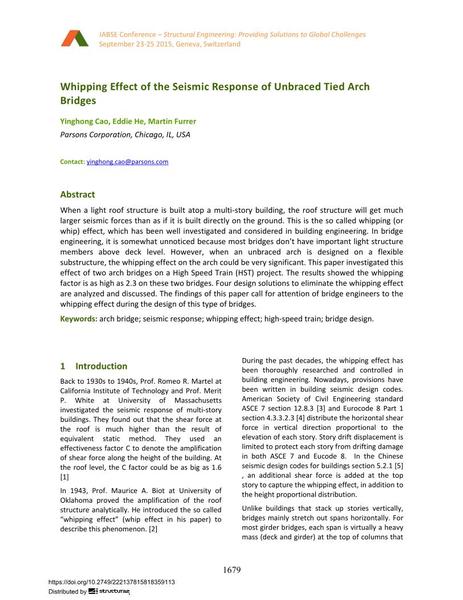Whipping Effect of the Seismic Response of Unbraced Tied Arch Bridges

|
|
|||||||||||
Bibliographic Details
| Author(s): |
Yinghong Cao
(Parsons Corporation, Chicago, IL, USA)
Eddie He (Parsons Corporation, Chicago, IL, USA) Martin Furrer (Parsons Corporation, Chicago, IL, USA) |
||||
|---|---|---|---|---|---|
| Medium: | conference paper | ||||
| Language(s): | English | ||||
| Conference: | IABSE Conference: Structural Engineering: Providing Solutions to Global Challenges, Geneva, Switzerland, September 2015 | ||||
| Published in: | IABSE Conference Geneva 2015 | ||||
|
|||||
| Page(s): | 1679-1686 | ||||
| Total no. of pages: | 8 | ||||
| Year: | 2015 | ||||
| DOI: | 10.2749/222137815818359113 | ||||
| Abstract: |
When a light roof structure is built atop a multi-story building, the roof structure will get much larger seismic forces than as if it is built directly on the ground. This is the so called whipping (or whip) effect, which has been well investigated and considered in building engineering. In bridge engineering, it is somewhat unnoticed because most bridges don’t have important light structure members above deck level. However, when an unbraced arch is designed on a flexible substructure, the whipping effect on the arch could be very significant. This paper investigated this effect of two arch bridges on a High Speed Train (HST) project. The results showed the whipping factor is as high as 2.3 on these two bridges. Four design solutions to eliminate the whipping effect are analyzed and discussed. The findings of this paper call for attention of bridge engineers to the whipping effect during the design of this type of bridges. |
||||
| Keywords: |
seismic response arch bridge bridge design high-speed train whipping effect
|
||||

